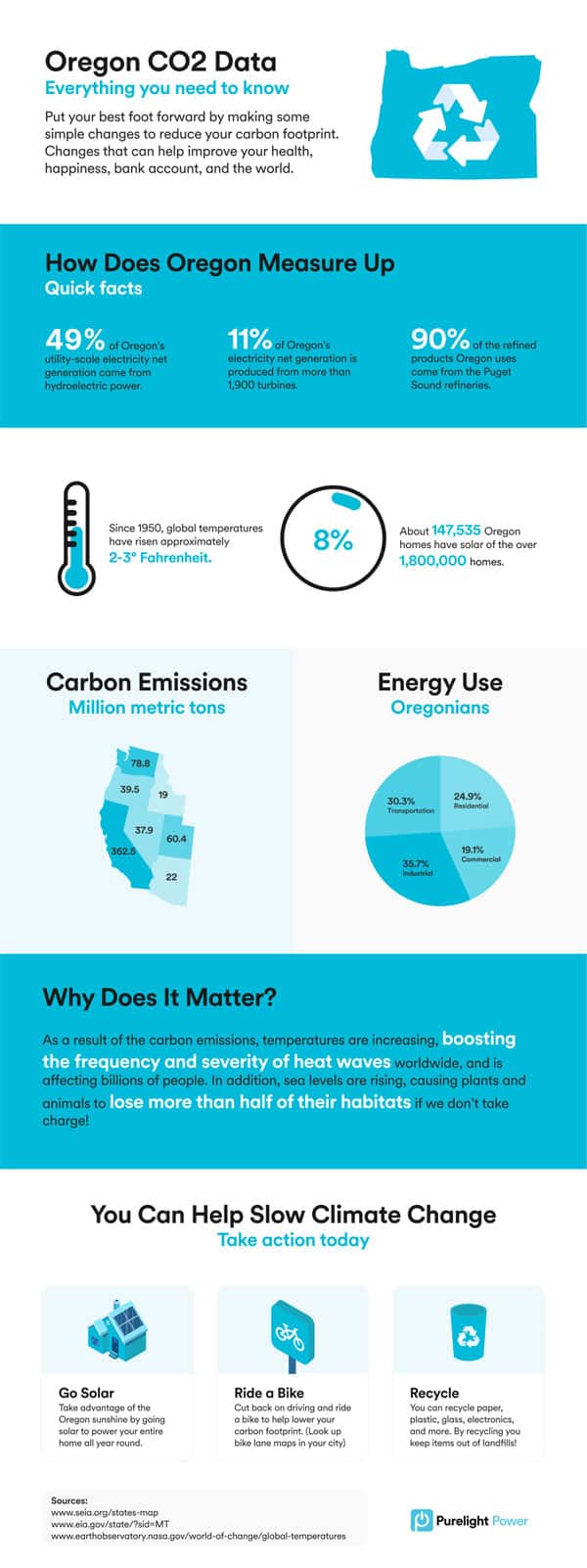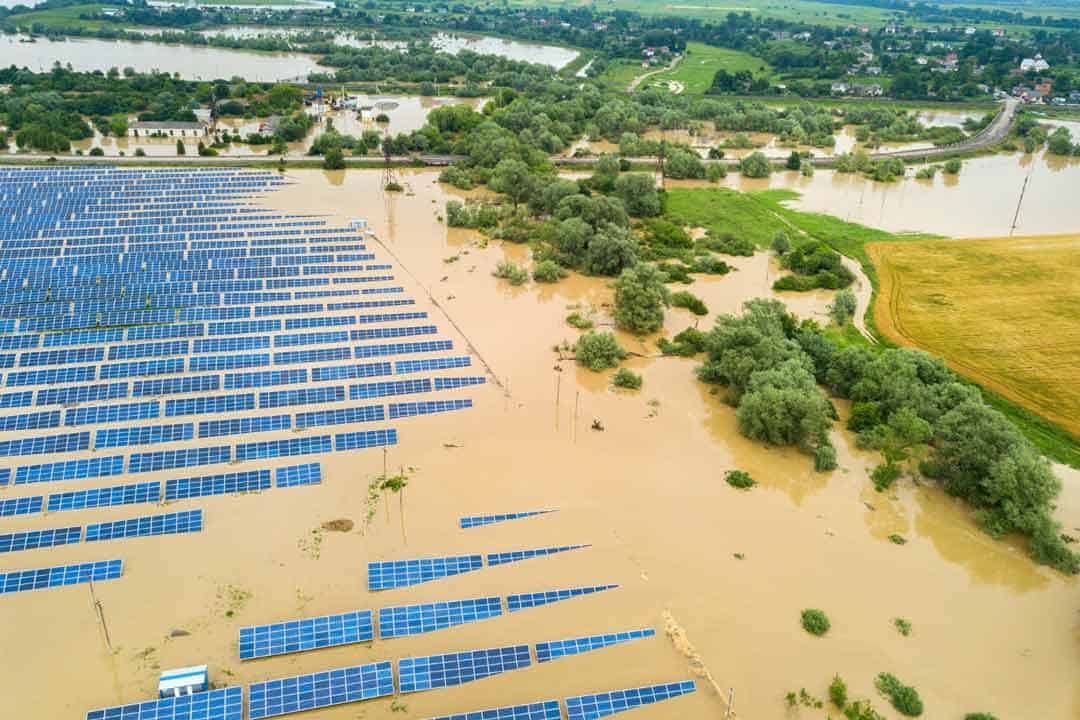You’ve likely heard the term carbon footprint sometime in the last few years. But do you know how your day-to-day lifestyle choices create your very own carbon footprint?
The average person in the US is responsible for around 16 tons of carbon dioxide (CO2) emissions every year. Or, put another way, enough to fill three and half Olympic-sized swimming pools.
While it’s true that a vast majority of CO2 emissions come from a handful of fossil fuel producing companies, that doesn’t mean that we all can’t have a hand in reducing carbon emissions as we respond to the very real threat of catastrophic climate change.
Each of us can make choices that reduce the amount of CO2 we’re responsible for, and help Oregon move towards a greener future. Many of these changes are minor and easy to make, which is even more of a reason to start now.
Below, we’ll go over everything you need to know to start reducing your own carbon footprint and help move Oregon towards a more sustainable future.
Carbon Footprint: What Is It?
The term carbon footprint might feel as difficult to grasp as confirming a Bigfoot sighting in the Willamette National Forest.
The simplest definition is that it’s the amount of carbon dioxide equivalent (CO2eq) released by a behavior (like driving a car), event, company, or product over time.
Everything from burning fossil fuels, clearcutting forests, raising livestock, heating and cooling Portland’s downtown skyscrapers, to flying on a plane all emit greenhouse gases including carbon dioxide and methane.
Why Should Oregonians Care About Their Carbon Footprints?
As Oregonians, we’re all pretty used to being stereotyped as outdoorsy types. And it’s true – across the state we work, play, and relax in the gorgeous variety of the great outdoors our state provides.
But given the increasingly destructive and longer fire seasons we’re seeing in the state, the prized green spaces and clean air of Oregon are under threat.
So how does your carbon footprint factor in? Greenhouse gases including CO2 absorb radiation and prevent heat from escaping from our atmosphere. This leads to more collected and stored heat, which in turn causes disrupted weather patterns and global temperatures to soar.
As the air and oceans heat up globally, we see irregular and more extreme weather patterns that lead to things like worsening droughts, crop losses, deathly heatwaves, and intense freak storms.
While methane and water vapor trap heat as well, CO2 presents the biggest threat of irreversible changes if we continue to let it accumulate in the atmosphere at dangerous levels.
How Can Your Reduce Your Carbon Footprint in Oregon?
In Oregon, transportation (e.g. driving your car), and home heating and cooling are the two main ways homeowners contribute to CO2 emissions.
Beyond these two contributors to greenhouse gas emissions, personal choices from the food we eat, to where we buy our clothes, home goods, and electronics from also factor into our carbon footprint. Albeit in a less direct way than direct use of gas and electricity.
Given the number of ways that our everyday choices impact our carbon footprint, you might feel overwhelmed at where to start.
Don’t stress! Below we’ll go over the top ways to quickly and easily reduce your footprint (and possibly save you some money too).
1. Choose Greener Home Energy
In Oregon you might assume your electricity is coming from reasonably green hydroelectricity. Hate to be the bearer of bad news, but Oregon still gets about half of its energy from coal and natural gas powered electric plants. Both of which belch carbon dioxide.
The good news is that as part of Oregon’s move towards truly renewable and sustainable energy options, homeowners who switch to a clean power option like solar are eligible for a tax incentive. As part of the commitment to help Keep Oregon Green, and as a smart move to increase home value and save on energy bills, Oregon homeowners are choosing solar power.
A home solar energy system means not only can you brag to friends about how easy it is being green, but you’ll make use of Oregon’s legally guaranteed net metering. Clean and way cheaper energy right on your rooftop? Yes please.
But does solar energy really make much of a difference?
Yes! A solar system for the first 5 years only emits about 50 grams of CO2 per kilowatt-hour. Natural gas and coal are 412 grams and 1002 grams for the same amount of energy. Installing solar power at home significantly reduces your carbon footprint.
2. Electric, Bikes, Walking, and Public Transportation
Transportation in Oregon (specifically from vehicles) represents 20% of CO2 emissions. That’s more than any other category on its own. While Oregon is working hard to change its power infrastructure to respond to climate change, reducing CO2 emissions from vehicles will largely be up to individual choices.
Besides Teslas (and Priuses!) being cool cars, moving to an all or hybrid electric vehicle can greatly reduce your carbon footprint. In Oregon you also can get another rebate for moving to an electric vehicle.
Understandably, not everyone can or wants to go out and purchase a new electric car. No worries, there are still plenty of options for reducing your transportation carbon emissions.
Check in with your local coffee shops, breweries, and grocery stores as well–many offer small discounts for customers who bike in.
Not to mention, public transportation is a great option to reduce your carbon footprint. You’ll even get the perk of being able to relax as you head to your destination, rather than wondering if the person in front of you is originally from California based on their driving.
If just one person in your family switched from driving to taking public transportation for their daily commute, that can amount to reducing carbon emissions by 4,627 fewer pounds of CO2 every year.
3. Focus on the Reuse part of Reduce-Reuse-Recycle
While buying less and buying local both can help to reduce carbon emissions, reusing rather than tossing items in your home has a significant impact as well.
Why? Because landfills release quite a bit of CO2 and methane into the atmosphere.
Finding ways to reduce how much you throw away by reusing items helps a ton. Beyond trying at home composting and keeping empty glass jars for vases and storage containers, reusing can be done in a number of other ways.
Options to up your reusing habits might include:
- Purchasing clothing and home goods from thrift stores
- Replacing single use plastic containers/shopping bags with reusable versions (saving you money and reduces carbon emissions associated with plastic production)
- Make use of FreeCycle and Buy Nothing Groups on social media to share items with neighbors rather than buying new or throwing away
- If you have any gardens, at home composting reuses food waste and gives you a nutrient dense soil
Join Oregon in reducing CO2 emissions
The evidence of rising global temperatures and climate change have become impossible to ignore in Oregon. From increased wildfires to concerns about vital and endemic species dying off with loss of habitat due to droughts.
In response, Oregon is moving to reduce carbon emissions statewide. The move is just one part of trying to reduce the negative effects of climate change in Oregon we can’t ignore.
Since 2016, Oregon has been working to move away from fossil fuels as a key component of reducing the state’s overall carbon footprint. A move that seems right in line with Oregon’s already abundant and growing use of renewable energy from hydroelectric, wind, and solar power sources.
But for Oregon homeowners who want to do more, there’s no reason to wait for bills to slowly make their way through our state’s legislature.
Solar Power Helps Oregon Homeowners Go Green
With heating and cooling costs one of the biggest sources of individuals’ carbon emissions, investing in home energy from clean sources can make a huge difference.
Frustratingly, the current power companies in Oregon continue to drag their feet on shuttering pollution heavy power plants.
Luckily, homeowners who are environmentally conscientious and want to reduce their carbon footprint have an affordable, local option for switching to a fully solar powered home. When you go solar, not only can you wipe out your power bill, but you’ll have the peace of mind of knowing that every watt of electricity in your home is safer for the environment.
But with time running out for homeowners to make the switch to solar AND take advantage of state and federal tax credits, if you’ve been considering solar home energy, now is the time.
More Ways to Combat Climate Change in Oregon
If you’re excited to make some simple changes to your daily life and have a positive impact on the environment, you might want to check out a calculator. By understanding where your carbon impact comes from more accurately, you can make even more changes.
Every person’s carbon footprint is as different as they are, so knowing the specifics of yours can help inform your actions towards a greener, more carbon neutral way of life.
Interested in getting started right now on your journey to lower CO2? Answer a few quick questions and find out if your roof is eligible for solar.






